

I hiked this area three times before finding the old house. It is about a 2-mile hike one-way. It starts as a defunct gravel road, then turns to a walk through an unmarked pine forest.
Nobody could remember where it was located, so I wandered around aimlessly the first couple of times until I began to find bits and pieces of other homes in the old community. I pulled maps from 1876, 1860, plat maps from the local Vinton County Engineer's office, and usgs.gov, below, showing the location of the haunted house in 1903.
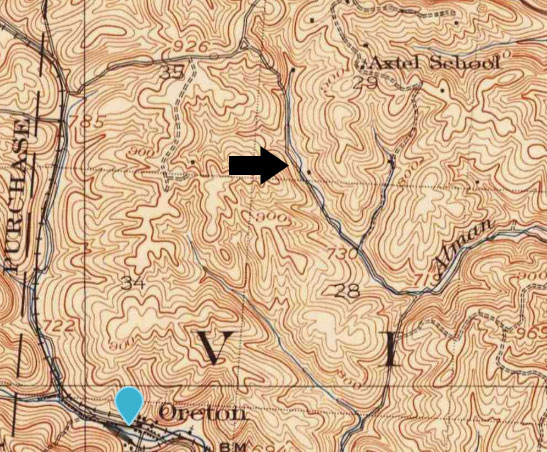
I found an old grave from the 1860s that belonged to the father of the murdered man.
I discovered where the old Axtel School was located along with a part of their old fence. I also found the home where the Axtel's lived (where the name Axtel Ridge had come from) and the road, mostly gone, that they took to get to the closest town.
I went here a couple times during hunting season and both Lucy and I wore the orange hunting vests because every time I looked up, there was a hunter in a tree stand giving us mean-eyes for tromping around in the leaves.
I also found my kids' threshold on creepy. They refused to hike to this place with me ever again after I dragged them along with me once and they have been to a lot of weird places.
On one trip, I had to pull 33 ticks off me. I got one stuck on my eyelid and had a black eye from it.
Lucy, my dog, had 54 that time. Yes, I count the ticks. I don't know why I do, but I do.
I hate, hate, hate ticks.
But I hate chiggers more. More on chiggers and my hate-relationship with them later.
All that is left of the house now are piles of bricks and a flat hill where the house stood.


The Haunted Well.
If you look at the center of the image, a small hole was once the well where a body was horridly dumped. My shadow wavers eerily above it while I take a picture. I walked this path many times, and always felt . . .I don't know, maybe a strange feeling of doubt when I passed nearby, and especially when it started to get dark because I had walked the creek below the house way too long.
Just so you know, I love to creek-walk. I like to find old pieces of plates and cups and bottles from people who used to live in the areas I hike. It is usually fine, but occasionally, I run into acid-mine drainage from old coal mines. The water is orange and disgusting.
Here is what it looks like now compared to then. Um, quite different! 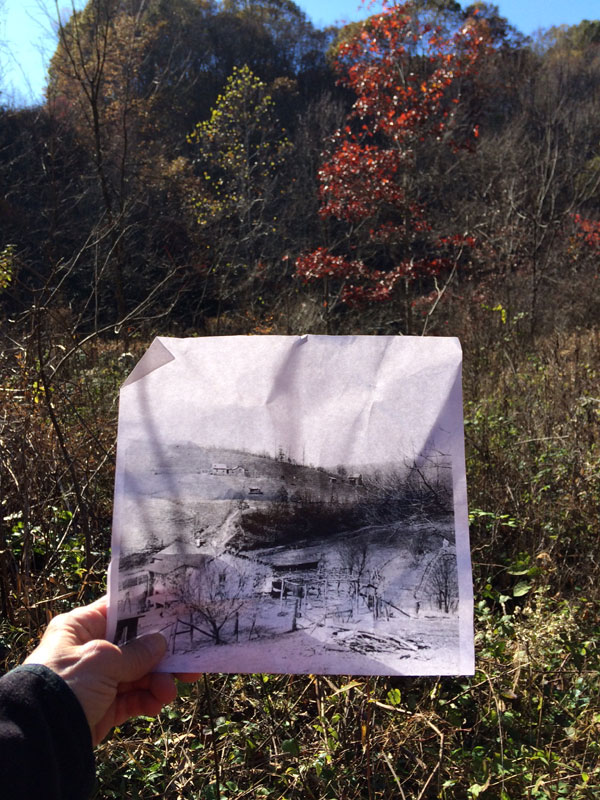
Nightmare on Axtel Ridge is in my Haunted Hocking A Ghost Hunter's Guide to the Hocking Hills ... and beyond: Ohio Ghost Hunter Guide (And it's twin, Ghost Stories of the Hocking Hills) 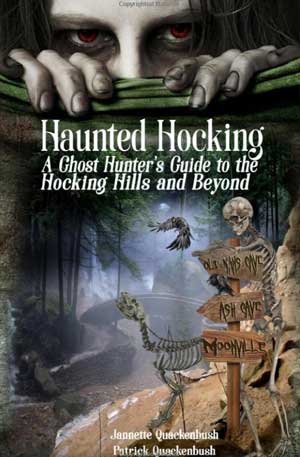
This is a true story. There were two murders with one on Axtel Ridge. Maude Collins, of Vinton County, was the first female sheriff in the state of Ohio and solved the case. She served two terms as sheriff of Vinton County after her husband was murdered. She was a widow with five little kids. Here is the image from the local historical society, Alice's House, that shows her with some of the local stills she took down. You can read more about Maude here. She must have been pretty bad-ass for a woman in those times. 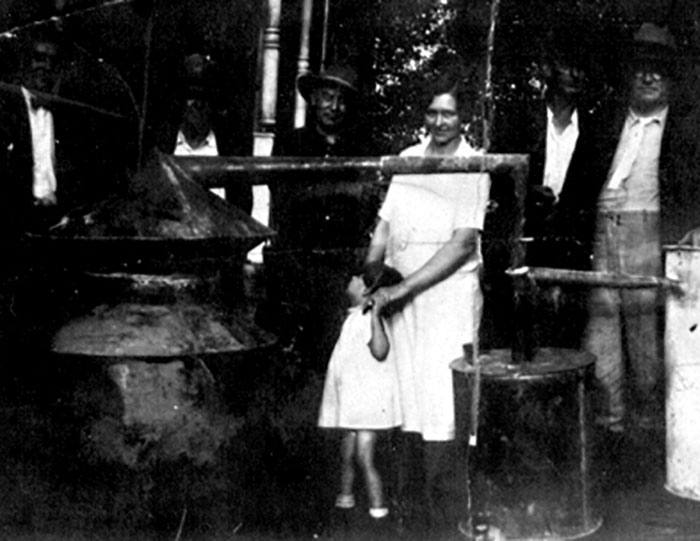
People living in the home and neighborhood after the murder heard strange sounds coming from the old well.
The first time I was told about the haunting was at the local historical society called Alice's House. I was digging up information on the haunted Moonville Tunnel and a worker pulled me aside, tugged out a notebook with a newspaper in it, and poked a finger at the picture. She said, "This place was haunted. You ever heard about it? It's the old Stout house . . ."
Here is the picture of the haunted house before it was razed. .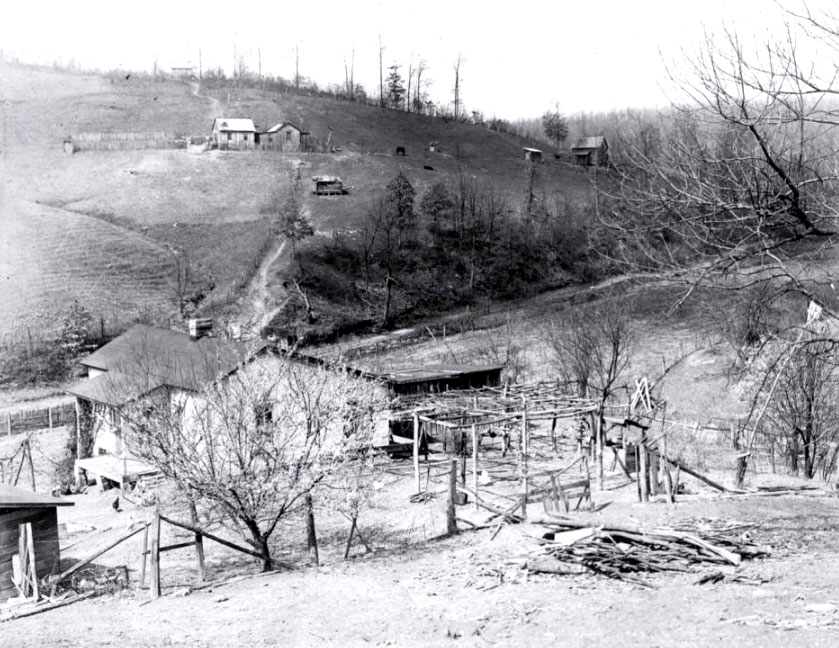
I had not head of it and was intrigued, but could find little more information until two years later when I stumbled upon a local who was related to Maude Collins and told me her story. Then another, whose family lived at the home, spoke of the ghostly activity. That's when the ghost story began to unfold and I started to hike the overgrown roads trying to find it. But it was more than just "a ghost story" for it began to drag me along for a ride.
Every one of us has our worst nightmares, the ones awakening us in the middle of the night in a cold, dripping sweat with heart hard-thumping like the frenzied, frantic beating of sticks to a marching band’s drums during halftime at a high school football game. Falling. Being Chased. Being alone. Ghosts. Handfuls of bugs crawling on you. What is your worst fear reflected in your dreams? Well, mine is getting lost—that world-spinning anxiety when I cannot retrace my last steps, or I cannot remember the direction of my previous jeep turn at an intersection of a road. I always have double GPS running for my rough country adventures. But when I am out and about foot hiking a backwoods trail, it is just me, my unpredictable cellphone, and my stupid sense of direction. Sometimes, when the trees and brush are thick, and there is no visible trail, I bring a roll of fluorescent orange vinyl tape. I rip a section off the roll and tie ribbons to limbs like tens of tiny streamers marking my way back to an easier-to-follow path, pulling each with relief on my return.
I am sure you are wondering where I am going with this, so I will get to the point. I was on the trail to find an old ghost story at one of southeastern Ohio’s Division of Forestry experimental areas. It has over 12,000 acres to get lost in, but I had my cellphone with two different mapping systems, although deep in the hollows, the little locator button jumps around and can be fickle at best. Thus, I also had my roll of bright orange vinyl tape. After three separate days of hiking the ridges and creeks, old roads, and hunter trails, I finally found what I was looking for—the place the old house once stood. The home is nearly gone. Prickly briers, thorny blackberry, poison ivy, and ancient planted pines have almost taken over the old property—the structure is nothing more than ruins tucked on a hillock at the edge of an overgrown ridge.
In the 1920s, though, it was part of the Axtel Ridge farming property of 65-year-old farmer William (Bill) Stout and his second wife, 58-year-old Sarah, and home to 34-year-old Arthur, a son from Bill’s previous marriage. Bill and Sarah had been married around 20 years, and she had helped raise Arthur since he was around 13-years-old. Sarah was probably not thrilled Arthur made a home nearby. There was friction between the two inflamed by disagreements here and there. They were two different souls. She was older, modest, and virtuous—perhaps a bit too much at times. Arthur was younger and could be indifferent, callous, and incorrigible —maybe a bit too much at times also.
Of course, the community chatter and gossip centering around Arthur’s improprieties did not improve the stepmother and stepson’s rocky relationship. It was just the opposite. Although highly respected among friends and neighbors, the Stouts had fallen prey to a few of the gossiping sort. In the spring of that year, Arthur had settled down in this little, four-room house on his father’s land. Along with him, he had brought a young woman, Inez Palmer, who was, by his accounts, hired to live in the home to do housework and help care for his sons—9-year-old William and 13-year-old Artie. Stepmother Sarah knew better, and so too did the locals. The matter escalated because the petite dark-haired, brown-eyed beauty, not much taller than five feet and weighing little more than a hundred pounds, appeared scandalously young.
It was evident that there was more to the relationship than Arthur had alluded. Sarah was a God-fearing woman, and enough so, she told her stepson the illicit behavior had to stop immediately. “Lasciviously associating and cohabiting in sin together” at the time was still illegal and could potentially land a couple in jail. Arthur snickered at his stepmother’s request and refused. Humbled and filled with righteousness, Sarah stomped down to the local justice of the peace and had him arrested in November of 1926 for cohabitating with the woman. His father, a less-rigid and peaceable man, believed jailing Arthur was too harsh a punishment. He hired a lawyer, and the court released Arthur on bond. Sarah remarked to a neighbor she feared greatly for her life after the release of her stepson.
Her apprehension was not unwarranted. A mere few days later, on November 17th, 1926, 14-year-old Manuel Perry was sent to the home of Bill Stout, not far from Arthur’s home, running an errand for his mother. When nobody answered the front door, he strolled innocently to the parlor door. He came across a terrifying scene—the bitter reek of burnt flesh hit his nostrils, and before his eyes lay a grisly mix of blood and charred skin. Sarah Stout was lying face down on the linoleum floor near the kitchen stove—badly beaten, and her clothing and head burned.
Maude Collins was the sheriff of Vinton County at the time, taking over the position after her husband, Sheriff Fletcher Collins, was shot at close range by a 12-gauge shotgun in 1925, issuing an arrest warrant to George Steele for speeding. On the day they found Sarah dead, she and her deputy arrived at the scene to find Bill Stout sitting on the porch steps and sobbing uncontrollably. It was not difficult to see that whoever had murdered the poor woman had waited for her to be alone and had made her feel secure enough to turn her back to her killer as there was a horrible blow to the rear of her head. The murder was coldblooded and calculated. Her usually easy-going husband was hardly a suspect, and his alibi, picking corn far in the fields, was corroborated. Perhaps the killer had toyed with the woman, working up a casual conversation before being invited into the house. It did not take long for an investigation to lead to Arthur Stout. It was not simply because bloodhounds ran from Arthur Stout’s home directly to Bill Stout’s kitchen. The dogs had howled and bayed, following the path the son had said he dragged a wagon tongue on horseback borrowed and returned to his father’s property. Arthur told officers he dropped the equipment at the barn. It was evident he had not because the hounds detected the scent to the home’s kitchen door. He was lying. Sheriff Collins was also aware of the resentment between stepson and stepmother, and she ordered Arthur’s arrest, direct evidence or not, for murder. When a deputy sheriff apprehended the man, it was noted Inez Palmer ran from the home and, most inappropriately, kissed Arthur quite passionately on the lips.
Now, Maude Collins was probably under a considerable amount of pressure to solve the crime under the circumstances that she was the first woman to hold the sheriff’s job in Ohio. But she had not just fallen into the position—Sheriff Maude Collins was bright, observative, and articulate. On February 17th, 1927, a Grand Jury indicted Arthur for the crime. On March 10th, Collins received a call from the Oreton Post Office, where folks from Axtel Ridge received their mail, stating Inez Palmer had left a message for her. The woman revealed that Bill Stout had suddenly left to go out West and start a new life. He would never return.
Sheriff Collins was immediately suspicious. After Sarah’s death, Bill Stout had moved into his son’s home on the ridge along an old dirt road with Inez and his grandsons. His grandsons needed family close-by, and the widowed farmer needed someone to cook and care for him. All along, Bill Stout refused to believe his son had murdered his wife. “I can’t believe that Arthur did it,” he had said adamantly. “But if he did, he certainly ought to be punished. If he is indicted and tried, then I’ll want to tell the jury that he was a good boy, but I’ll have to admit he and Sarah didn’t get along—” That Bill would suddenly decide to leave his home in Vinton County and his close family seemed absurd. But had Bill been the killer after all and left town as not to be arrested? Sheriff Collins immediately took the old dirt and rutted road to remote Axtel Ridge. She questioned Inez Palmer at Arthur Stout’s home to investigate this new twist in the homicide case. However, when police arrived at the scene and discovered Bill had left his car and belongings, it was clear there was foul play. Upon direction of Inez Palmer, Collins followed a set of large-boot footprints to a field Bill had allegedly taken to mend a fence the day he left. She discovered a lunch pail along the route, and within, a makeshift will bequeathing both farms to Arthur Stout alone. Even more suspect, Collins observed the boot prints were not embedded deeply enough in the soft earth for a man’s heavy weight. Upon returning, the sheriff saw the boys Artie and William lugging up buckets of water from the creek; she questioned the boys why they were not taking water from a perfectly good well behind the house. One answered that Inez had told them not to take water from the well; it was not fit to drink anymore. The sheriff rushed to the well, peered downward, and found Bill Stout’s corpse dumped in the icy waters partway down.
Pieces of a grisly puzzle would fall into place when, not long after, Artie and William confessed their father had encouraged and talked often at the dinner table about murdering his parents, eventually persuading Inez and the children to do the dirty deed. It was a cold-blooded and well-calculated plan laid out after he offered Inez’s brother $50.00 to commit the murders, and the young man had refused.
Artie would admit that one morning Inez had talked him into going to the home of the elder Stouts. She made it appear her visit was nothing more than a quick, benign chat and “--by the way, while we are here, could Arthur borrow Bill’s gun?” Sarah had nodded. Was she walking into some trap? Indeed, she was suspicious of the motive. Was Inez toying with her fears she would be murdered right there? Certainly not with little Artie by her side! Sarah had taken the bait, even if reluctantly. Her head was probably swimming with doubt, fear gripping her soul. Together, the three entered the home. As Sarah stooped over in the closet to get the weapon, Inez swooped forward and hit the old woman over the head with a weight. She then leaped on her back and choked her to death with a strip of a bed sheet. Next, Inez demanded the boy pour kerosene on the body and light it on fire to hide the evidence. But the linoleum would not catch fire as they planned; instead, the small flames barely singed the woman’s dead body, clothing, and hair.
As for Bill’s death in Arthur Stout’s home, Inez bided her time, waiting for him to sit by the fireplace one chilly February night in 1927 just as he always did. A neighbor once remarked that most evenings, Inez would play on a little piano in the home, pounding the keys incessantly and singing off-key at the top of her lungs until Bill moved in with the youngsters. Once there, he made her stop, telling Inez that it was disrespectable to his dead wife’s memory. Inez had watched the old man lean forward to poke the fire, then beat him in the back of the head with a piece of cord wood. She, Artie, and William dragged the cumbersome load to the well and shoved the old man into its dark depths. Inez had attempted to cover up Bill’s murder by donning a pair of his boots and walking to the field to make it appear he had been mending fences. She had faked the will. The night Bill disappeared, the sound of fingers banging the keys of a piano and the caterwauling voice of the young woman swept again through the hills. It crept along the misty hollows, above a creek, and then up another hill to a neighbor’s ears whose home overlooked Arthur Stout’s house. And those who heard had known something was amiss.
Not long ago, I followed the old roads and paths to the remains of the house where Arthur and Inez lived before sent to prison for the murders of Sarah and Bill Stout. I pushed aside the brush and zigzagged through the pine trees tying orange vinyl tape to limbs and trunks, looking back each time anxiously to make sure my trail was well-marked. I suspected no foul play as I wandered between old houses and finally stood where Inez Palmer murdered Bill Stout and dumped his body into the well. I found pieces of old dishes, a broken beer bottle, and an old cooking pot. I waited for a ghost, but none showed. Although old-timers told me the house and land where I stood was haunted, I was unsure if it was Bill Stout, his murderous son, or even his young lover Inez who was once said to make an appearance.
It was getting dark, too dark for my lonesome self to trace back my steps with only the help of orange vinyl streamers clinging desperately to trees now fading in a misty fog and a persnickety cell phone to guide my way. The rain that had been holding off was starting to become steady in the evening gloom. I was a bit disappointed, but I know the dead do not rise for anyone but themself. I sighed. I had an hour or so to traverse the eerie and seemingly endless miles of pine trees to return to the safety of my jeep. Good grief, I certainly did not want to get lost! Far off, there was a hunter camp. Once in a while, in the nearly silent air, I could hear the gentle flow of a radio playing and hear a truck chug down a gravel road. I started to retrace my steps. I came upon one vinyl orange streamer, plucked it from the dead branch I tied it on, and searched for the next. Easy-peasy. I found another barely clinging to the limb. With some difficulty, I had to struggle to find the third and fourth because they were lying on the ground. I was confident I tied those knots tight. Perhaps not, though. I sighed and noted that for next time, I would be more cautious. Yet, the path seemed slightly different as if I was going right, then left along the ridge. I was sure my original trail was straight, and I didn’t think the streamers would have blown that far away. Instead, I was zig-zagging right to left and certainly closer to the edge of the crest than I remember. I had hiked straight down the center. I heard the music, still far off, and the sound of it should have been comforting. It was not. It seemed to be behind me and not in front. Was that the sound of fingers banging a piano? Or my imagination? I wandered aimlessly but managed to see a bit of what I believed was an old dirt path covered in autumn leaves and pine needles beneath my feet. I swear, for a moment, I was a mile off my original route. My heart was pounding. I kept forging forward, getting that awful anxiety gripping my chest as I found two more of my streamers lying on the pine needle forest floor. What the heck? Perhaps it was the wind untying my loose knots and tossing them to the breeze. Or perhaps not. The pine trees around me were starting to swirl. Surely nobody else was out here toying with me, thinking it was funny to move my tiny trail banners. I waited for laughter. There was none. Then I saw it, up ahead—a small streamer clinging to a pine tree near my main path that would take me to the old dirt road. I sighed in relief and set my sights right on it—until I stopped dead in my tracks. As I stood there and right before my eyes, the little strand of orange vinyl tape I had so carefully tied on that specific branch unraveled all on its own, wiggle-wiggle like unseen fingers were unwinding the ends. It clung to the knotted limb, untangled and rippling, not three seconds before a bit of wind took it to the ground and off into the darkness. I shuddered. Was this a game, well calculated, scheming? I felt dizzy again, but only because I was holding my breath. I made hasty steps to my jeep. I did not want to be stuck on Axtel Ridge alone in the darkness with things that were manipulating, coldblooded, and toying with my greatest fear reflected in my nightmares that something sniffed out and identified deep within me. Just like they had done to Sarah. Just like they had done to Bill. Because I knew it was not only one calculating being there this night unraveling my orange vinyl streamers one by one and letting each ride the wind. It was two. And they knew exactly what they were doing. Because now they are not alone on the ridge anymore. They are with me every night, lurking only steps behind me when I get lost in my nightmares.
Monsters
Folklore
Jannette Quackenbush
The Paranormal
ghost stories
...and much more